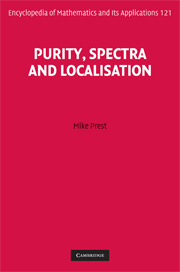Book contents
- Frontmatter
- Contents
- Preface
- Introduction
- Part I Modules
- Part II Functors
- 10 Finitely presented functors
- 11 Serre subcategories and localisation
- 12 The Ziegler spectrum and injective functors
- 13 Dimensions
- 14 The Zariski spectrum and the sheaf of definable scalars
- 15 Artin algebras
- 16 Finitely accessible and presentable additive categories
- 17 Spectra of triangulated categories
- Appendix B Languages for definable categories
- Appendix C A model theory/functor category dictionary
- Part III Definable categories
- Appendix D Model theory of modules: an update
- Appendix E Some definitions
- Main examples
- Bibliography
- Index
14 - The Zariski spectrum and the sheaf of definable scalars
from Part II - Functors
Published online by Cambridge University Press: 05 March 2013
- Frontmatter
- Contents
- Preface
- Introduction
- Part I Modules
- Part II Functors
- 10 Finitely presented functors
- 11 Serre subcategories and localisation
- 12 The Ziegler spectrum and injective functors
- 13 Dimensions
- 14 The Zariski spectrum and the sheaf of definable scalars
- 15 Artin algebras
- 16 Finitely accessible and presentable additive categories
- 17 Spectra of triangulated categories
- Appendix B Languages for definable categories
- Appendix C A model theory/functor category dictionary
- Part III Definable categories
- Appendix D Model theory of modules: an update
- Appendix E Some definitions
- Main examples
- Bibliography
- Index
Summary
The Gabriel–Zariski topology associated to a locally finitely presented additive category is introduced. This topology for the functor category is shown to be equivalent to the dual-Ziegler topology for the module category. The “structure sheaf” formed by rings of definable scalars over this topology is defined and computed for certain types of ring.
The Gabriel–Zariski spectrum
In Section 14.1.1 we see how to define the Zariski spectrum of a commutative noetherian ring purely in terms of its category of modules. This results in a definition that makes good sense in any locally finitely presented abelian category and yields, in Section 14.1.2, a spectrum based on indecomposable injectives. This space carries a presheaf of localisations which we also define.
The coincidence of various topologies over various types of ring is considered in Section 14.1.3 and it is shown in that section that the dual-Ziegler and rep-Zariski topologies coincide.
We are going to define a presheaf of rings over the set, pinjR, of isomorphism types of indecomposable pure-injective right R-modules equipped with the dual-Ziegler topology. That topology was defined in Section 5.6 and we will see another way of defining it here.
Information
- Type
- Chapter
- Information
- Purity, Spectra and Localisation , pp. 549 - 581Publisher: Cambridge University PressPrint publication year: 2009
